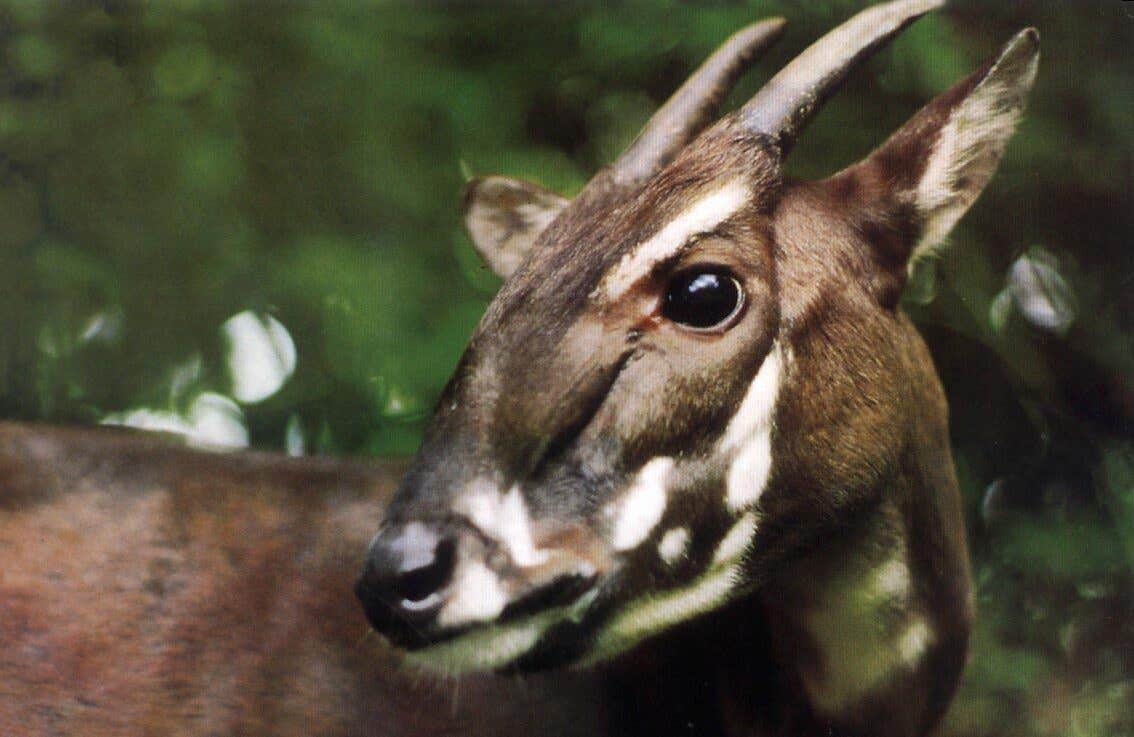The Saola is the official mascot of the 2022 Southeast Asian Games, which is great exposure for the species because so few people have ever seen one! In celebration of the games, which run from May 12 to May 23, we’re sharing some of our favorite facts about the incredibly rare and elusive Saola.
Although the Saola, a Critically Endangered species endemic to the Annamite Mountains straddling Vietnam and Laos, is frequently called “the Asian unicorn,” the title is a little bit of a misnomer. It’s a species of wild cattle, not a mythical creature. And it doesn’t have one horn, it actually has two. Its nickname pays homage to its elusiveness. It is so rare, no scientist has actually ever seen one in the wild.
If you have sharp detective skills, you might be wondering how scientists know the Saola is real if they have never seen one for themselves in the wild? Don’t worry Sherlock, there is concrete evidence! The Saola wasn’t known to western science until 1992 (though people in Vietnam and Laos knew the species had existed for a very long time) when researchers came across the skull of a Saola in a hunter’s house in a remote village in Vietnam. The distinctive black horns, which can grow up to 20 inches long, and arch gently up and back from the top of the Saola’s head, were a major clue that the species was new to science. No other Asian wild cattle species has similar tapered horns.
And even though Saola are basically as easy to see as ghosts, they haven’t managed to totally evade photos. Scientists have captured a few camera trap photos of wild Saola in Vietnam. The candid photos are taken by remote cameras, triggered by movement, and are kind of like paparazzi photos, but for conservation instead of profit. The last camera trap photo of a Saola was taken in 2013. However, local people still report sightings of Saola, so conservationists think there is still time to save the species but they need to act quickly!
The Saola has large glands on its face, some of the largest of any mammal, that secrete a thick, mucus-like substance. And you thought you had sinus problems! The reason for this secretion is not known but may be related to marking its territory.
Saola means “spinning-wheel-post-horn” in a local language in Vietnam. Although it’s distantly related to other Asian wild cattle species, like the Tamaraw, it looks very different. With its brown fur and white face-markings, it kind of looks like a combination of a goat and an antelope. Its Latin scientific name, Pseudoryx nghetinhensis, is also a nod to the species’ uniqueness. Its horns are reminiscent of oryx, which are found in northern Africa. Pseudoryx means “false oryx.”
Conservationists think that it’s likely that there are only a handful of Saola living in isolated populations in the forest of the Annamite Mountains. Re:wild is supporting local conservation organizations trying to protect and save Saola. We collaborate with partners to support a One Plan Approach to Saola conservation, which is being facilitated by the IUCN Saola Working Group, the global coordinating body for Saola conservation. The One Plan Approach integrates conservation breeding under human care and protecting the species in the wild into a single conservation program. Combined, the two components help the species’ long-term conservation.
Conservationists have been really creative looking for traces of Saola. They set camera traps, analyzed dung, and have even analyzed the blood consumed by leeches in Vietnam to see if it contains any Saola DNA. If they get any matches, they can use that information to target searches.
Although scientists know that Saola live in the Annamite Mountains and are Critically Endangered, they don’t know very much else about the species. Searches for the Saola, conducted by local partners in the Annamites and coordinated by the Saola Working Group, are hoping to provide more information about the species–some of which could be helpful in conservation breeding.
The biggest threat to Saola and many other Annamite species is snaring. Wire snares are commonly used by poachers in the Annamites, and they are so widespread it has led to “empty forest syndrome” in some places. Rangers in places like Pu Mat National Park in Vietnam patrol areas removing wire snares to help prevent wildlife crime and protect highly threatened species like Saola.
The Saola isn’t the only rare species in the Annamites. The region is also home to the Silver-back Chevrotain, a small deer-like species that was lost to science for almost 30 years until it was rediscovered in 2019; the Annamite Striped Rabbit; and the Large-antlered Muntjac, which like chevrotain are fanged-deer (yes, you read that right).

Devin Murphy
Writer
Devin Murphy is Re:wilds’s senior communications specialist and helps Re:wild and its partners tell stories about the work they do to protect wildlife and wildlands around the planet. Her favorite stories about conservation include fascinating and little-known species and the dedicated humans protecting them.



